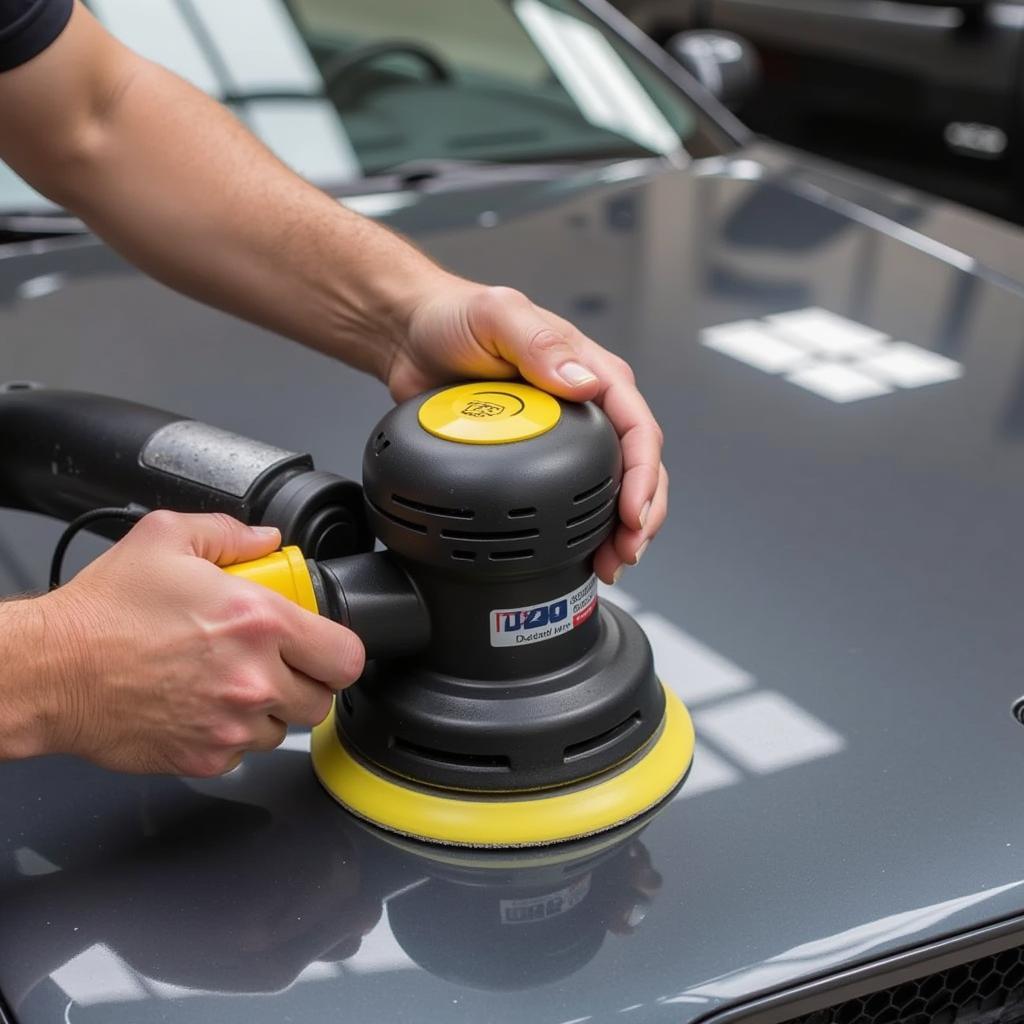Removing paint from a car is a common task, whether you’re prepping for a respray, tackling rust spots, or restoring a classic. Choosing the right tools to sand paint off a car can make all the difference between a smooth, professional finish and a scratched, uneven surface. This guide will explore the various tools available, from manual sanding blocks to powerful sandblasters, and help you choose the best option for your project. After reading this, you’ll be well-equipped to choose the right tools for your specific needs and skill level.
Sanding by Hand: The Foundation of Paint Removal
Hand sanding is often the first step in any paint removal project, allowing for precise control and minimizing the risk of damaging the underlying metal. While it can be time-consuming, hand sanding is essential for detailed work and reaching tight corners.
Sandpaper: Grit Matters
Sandpaper comes in various grits, from coarse to fine. Start with a coarser grit (e.g., 80-grit) for initial paint removal and gradually move to finer grits (e.g., 220-grit) for smoothing the surface. Using the right grit sequence is crucial for achieving a professional finish.
What grit sandpaper should I use to remove paint from a car? Start with 80-grit and work your way up to 220-grit.
For smaller areas or intricate details, sanding blocks offer better control and a more even surface than just using sandpaper alone. They come in various shapes and sizes, making them versatile for different areas of the car.
Power Tools: Speeding Up the Process
For larger areas or thicker paint layers, power tools can significantly reduce the time and effort required. Several options are available, each with its own advantages and disadvantages.
Orbital Sanders: Versatile and Efficient
Orbital sanders provide a good balance between speed and control. They are excellent for removing paint from flat or slightly curved surfaces. Variable speed control allows for adjusting the sanding intensity based on the paint’s thickness and the desired finish.
 Orbital sander being used to remove paint from a car
Orbital sander being used to remove paint from a car
What is the best power tool for sanding car paint? Orbital sanders are a versatile and efficient choice for many paint removal tasks.
DA Sanders: Combining Rotation and Oscillation
Dual-action (DA) sanders combine rotational and orbital movements, offering faster paint removal and a smoother finish than standard orbital sanders. They are ideal for tackling tougher paint jobs and achieving a swirl-free surface.
Sandblasters: Aggressive Paint Stripping
Sandblasters use compressed air to propel abrasive media (e.g., sand, soda) at high velocity, effectively stripping paint from even the most stubborn surfaces. However, sandblasting requires careful control to avoid damaging the underlying metal. It’s best suited for experienced users.
Choosing the Right Tool: Factors to Consider
Selecting the appropriate tools depends on various factors, including the size of the area, the type of paint, the desired finish, and your skill level. Consider these factors before making a decision.
-
Project Size: Hand sanding is suitable for small areas or intricate details. Power tools are more efficient for larger areas.
-
Paint Type: Some paints are more resistant to removal than others. Choose a tool powerful enough to handle the specific type of paint.
-
Desired Finish: If a smooth finish is critical, using finer grits and DA sanders is recommended.
-
Skill Level: Sandblasters require experience and should be used with caution.
buy tools for repairing dents on cars
“When choosing tools for sanding paint, consider the project size and your skill level. A DA sander is a great all-around choice, while hand sanding is essential for detail work.” – John Smith, Automotive Restoration Specialist
Conclusion
Removing paint from a car requires the right tools and techniques. From manual sanding blocks to powerful sandblasters, choosing the appropriate tool is crucial for achieving a professional finish. Consider the size of the project, the type of paint, and your skill level to make the best decision. By following the guidance in this article, you’ll be well-equipped to tackle your next paint removal project with confidence.
FAQ
- Can I use a power drill for sanding car paint? While possible, a dedicated sander offers better control and results.
- How do I avoid damaging the metal when sanding? Start with coarser grits and gradually move to finer ones.
- What safety precautions should I take when sanding paint? Wear safety glasses, gloves, and a dust mask.
- What’s the best way to remove rust before sanding? Use a rust remover or a wire brush.
- Can I sand paint off fiberglass? Yes, but use extra caution as fiberglass is more delicate than metal.
- Should I wet sand car paint? Wet sanding can provide a smoother finish but requires specialized equipment.
- How do I dispose of sanded paint dust? Collect the dust and dispose of it according to local regulations.
Common Situations and Questions:
- Peeling Clear Coat: If only the clear coat is peeling, you might only need to sand the affected area and reapply clear coat.
- Rust Removal: When dealing with rust, make sure to remove all rust before sanding and priming.
- Deep Scratches: Deep scratches may require filling with body filler before sanding and painting.
Further Reading and Resources:
Check out our other articles on car repair and maintenance for more helpful tips and advice. See our article on the best tool to cut rust from car.
Need further assistance with your car diagnostic and repair needs? Contact us via WhatsApp: +1(641)206-8880, Email: [email protected], or visit our workshop at 910 Cedar Lane, Chicago, IL 60605, USA. Our 24/7 customer support team is ready to assist you.
